Business Environment Report: British Airways Analysis (BUS101)
VerifiedAdded on 2019/12/03
|14
|4860
|253
Report
AI Summary
This report provides a comprehensive analysis of the business environment impacting British Airways (BA). It begins by defining the purposes of different organizational types and BA's mission and vision. The report then explores BA's responsibilities towards its stakeholders, including customers, employees, government, and suppliers. It examines various economic systems and their implications for BA, including command, free enterprise, mixed, and transitional economies. The analysis further delves into the challenges posed by fiscal and monetary policies, as well as the impacts of regulatory, competition policies, and legal changes on BA's operations. The report investigates market structures, the interplay of market forces, and the influence of global factors, including trade regimes, government policies, and EU policies, on the airline. The report concludes with a summary of the findings and provides recommendations for BA to navigate the complexities of its business environment.
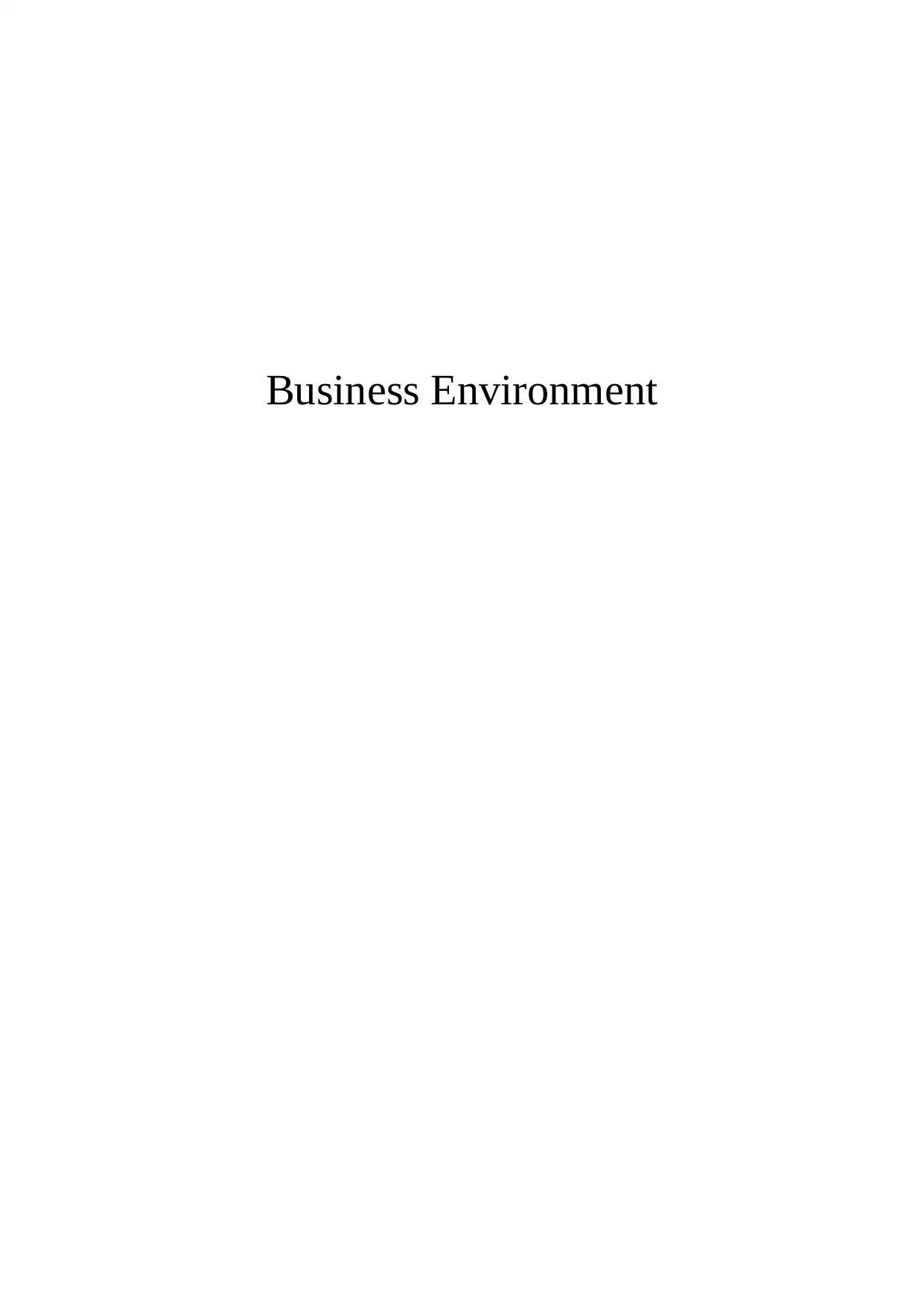
Business Environment
Paraphrase This Document
Need a fresh take? Get an instant paraphrase of this document with our AI Paraphraser
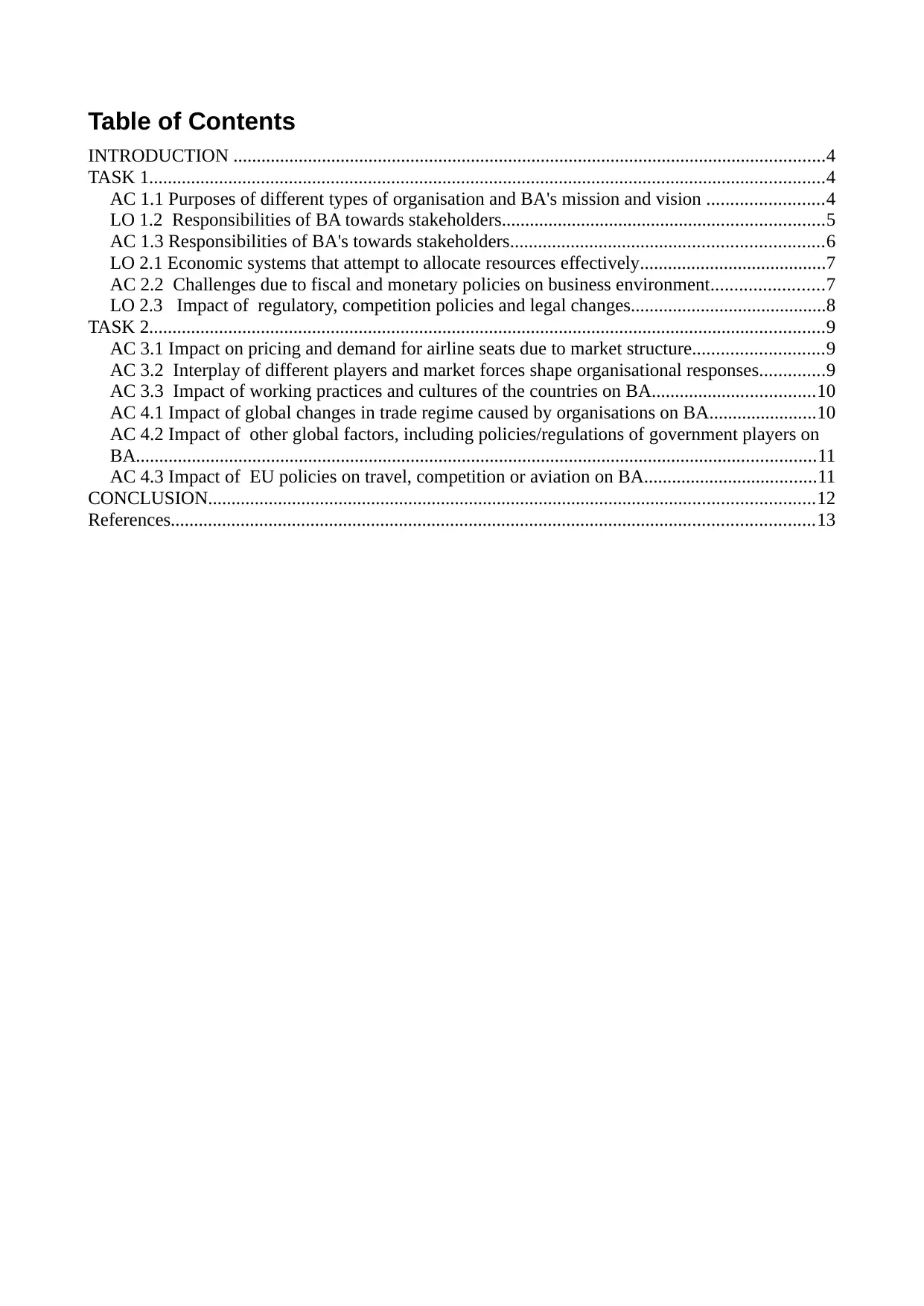
Table of Contents
INTRODUCTION ...............................................................................................................................4
TASK 1.................................................................................................................................................4
AC 1.1 Purposes of different types of organisation and BA's mission and vision .........................4
LO 1.2 Responsibilities of BA towards stakeholders.....................................................................5
AC 1.3 Responsibilities of BA's towards stakeholders...................................................................6
LO 2.1 Economic systems that attempt to allocate resources effectively........................................7
AC 2.2 Challenges due to fiscal and monetary policies on business environment........................7
LO 2.3 Impact of regulatory, competition policies and legal changes..........................................8
TASK 2.................................................................................................................................................9
AC 3.1 Impact on pricing and demand for airline seats due to market structure............................9
AC 3.2 Interplay of different players and market forces shape organisational responses..............9
AC 3.3 Impact of working practices and cultures of the countries on BA...................................10
AC 4.1 Impact of global changes in trade regime caused by organisations on BA.......................10
AC 4.2 Impact of other global factors, including policies/regulations of government players on
BA..................................................................................................................................................11
AC 4.3 Impact of EU policies on travel, competition or aviation on BA.....................................11
CONCLUSION..................................................................................................................................12
References..........................................................................................................................................13
INTRODUCTION ...............................................................................................................................4
TASK 1.................................................................................................................................................4
AC 1.1 Purposes of different types of organisation and BA's mission and vision .........................4
LO 1.2 Responsibilities of BA towards stakeholders.....................................................................5
AC 1.3 Responsibilities of BA's towards stakeholders...................................................................6
LO 2.1 Economic systems that attempt to allocate resources effectively........................................7
AC 2.2 Challenges due to fiscal and monetary policies on business environment........................7
LO 2.3 Impact of regulatory, competition policies and legal changes..........................................8
TASK 2.................................................................................................................................................9
AC 3.1 Impact on pricing and demand for airline seats due to market structure............................9
AC 3.2 Interplay of different players and market forces shape organisational responses..............9
AC 3.3 Impact of working practices and cultures of the countries on BA...................................10
AC 4.1 Impact of global changes in trade regime caused by organisations on BA.......................10
AC 4.2 Impact of other global factors, including policies/regulations of government players on
BA..................................................................................................................................................11
AC 4.3 Impact of EU policies on travel, competition or aviation on BA.....................................11
CONCLUSION..................................................................................................................................12
References..........................................................................................................................................13

⊘ This is a preview!⊘
Do you want full access?
Subscribe today to unlock all pages.

Trusted by 1+ million students worldwide
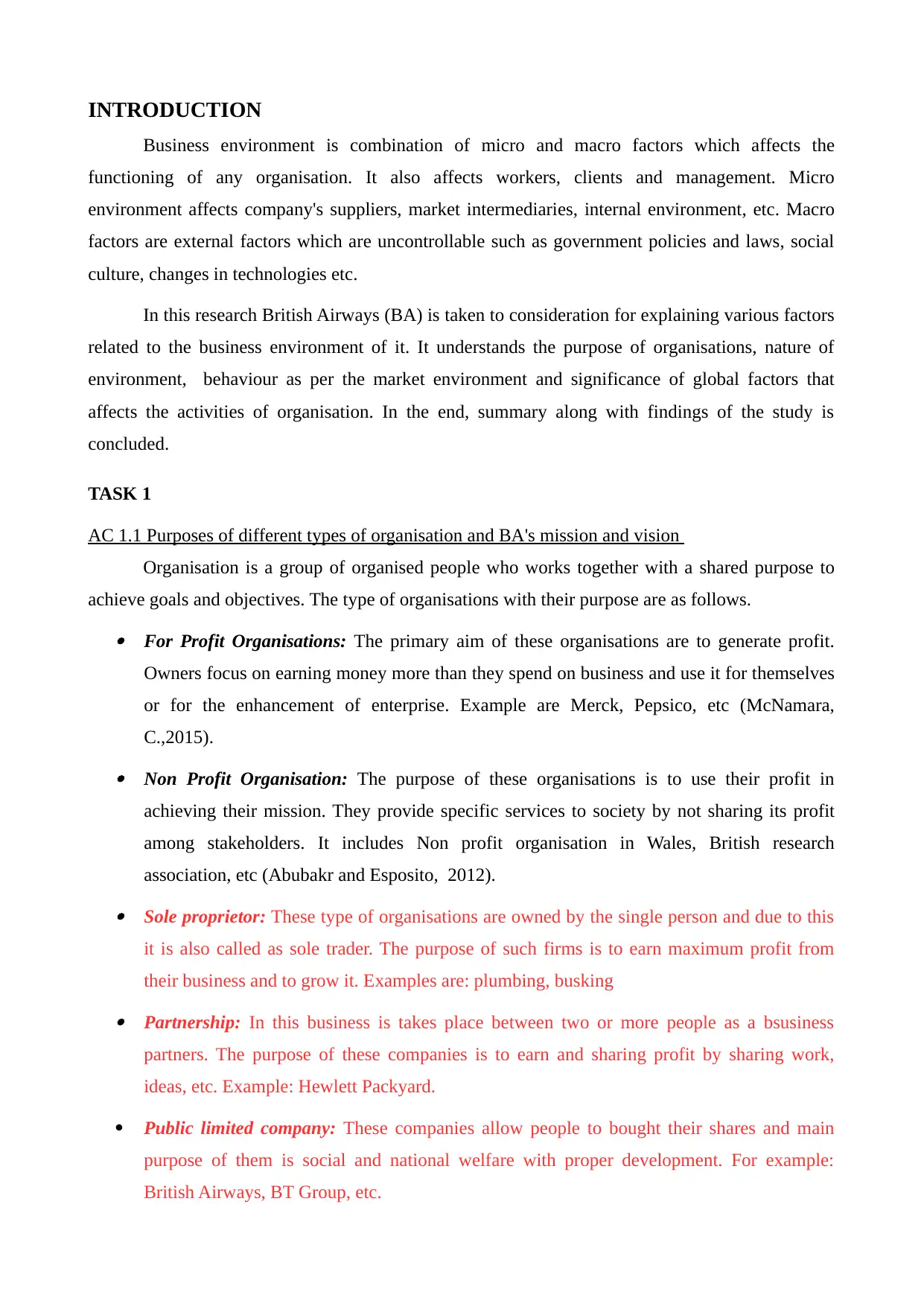
INTRODUCTION
Business environment is combination of micro and macro factors which affects the
functioning of any organisation. It also affects workers, clients and management. Micro
environment affects company's suppliers, market intermediaries, internal environment, etc. Macro
factors are external factors which are uncontrollable such as government policies and laws, social
culture, changes in technologies etc.
In this research British Airways (BA) is taken to consideration for explaining various factors
related to the business environment of it. It understands the purpose of organisations, nature of
environment, behaviour as per the market environment and significance of global factors that
affects the activities of organisation. In the end, summary along with findings of the study is
concluded.
TASK 1
AC 1.1 Purposes of different types of organisation and BA's mission and vision
Organisation is a group of organised people who works together with a shared purpose to
achieve goals and objectives. The type of organisations with their purpose are as follows.
For Profit Organisations: The primary aim of these organisations are to generate profit.
Owners focus on earning money more than they spend on business and use it for themselves
or for the enhancement of enterprise. Example are Merck, Pepsico, etc (McNamara,
C.,2015).
Non Profit Organisation: The purpose of these organisations is to use their profit in
achieving their mission. They provide specific services to society by not sharing its profit
among stakeholders. It includes Non profit organisation in Wales, British research
association, etc (Abubakr and Esposito, 2012).
Sole proprietor: These type of organisations are owned by the single person and due to this
it is also called as sole trader. The purpose of such firms is to earn maximum profit from
their business and to grow it. Examples are: plumbing, busking
Partnership: In this business is takes place between two or more people as a bsusiness
partners. The purpose of these companies is to earn and sharing profit by sharing work,
ideas, etc. Example: Hewlett Packyard.
Public limited company: These companies allow people to bought their shares and main
purpose of them is social and national welfare with proper development. For example:
British Airways, BT Group, etc.
Business environment is combination of micro and macro factors which affects the
functioning of any organisation. It also affects workers, clients and management. Micro
environment affects company's suppliers, market intermediaries, internal environment, etc. Macro
factors are external factors which are uncontrollable such as government policies and laws, social
culture, changes in technologies etc.
In this research British Airways (BA) is taken to consideration for explaining various factors
related to the business environment of it. It understands the purpose of organisations, nature of
environment, behaviour as per the market environment and significance of global factors that
affects the activities of organisation. In the end, summary along with findings of the study is
concluded.
TASK 1
AC 1.1 Purposes of different types of organisation and BA's mission and vision
Organisation is a group of organised people who works together with a shared purpose to
achieve goals and objectives. The type of organisations with their purpose are as follows.
For Profit Organisations: The primary aim of these organisations are to generate profit.
Owners focus on earning money more than they spend on business and use it for themselves
or for the enhancement of enterprise. Example are Merck, Pepsico, etc (McNamara,
C.,2015).
Non Profit Organisation: The purpose of these organisations is to use their profit in
achieving their mission. They provide specific services to society by not sharing its profit
among stakeholders. It includes Non profit organisation in Wales, British research
association, etc (Abubakr and Esposito, 2012).
Sole proprietor: These type of organisations are owned by the single person and due to this
it is also called as sole trader. The purpose of such firms is to earn maximum profit from
their business and to grow it. Examples are: plumbing, busking
Partnership: In this business is takes place between two or more people as a bsusiness
partners. The purpose of these companies is to earn and sharing profit by sharing work,
ideas, etc. Example: Hewlett Packyard.
Public limited company: These companies allow people to bought their shares and main
purpose of them is social and national welfare with proper development. For example:
British Airways, BT Group, etc.
Paraphrase This Document
Need a fresh take? Get an instant paraphrase of this document with our AI Paraphraser
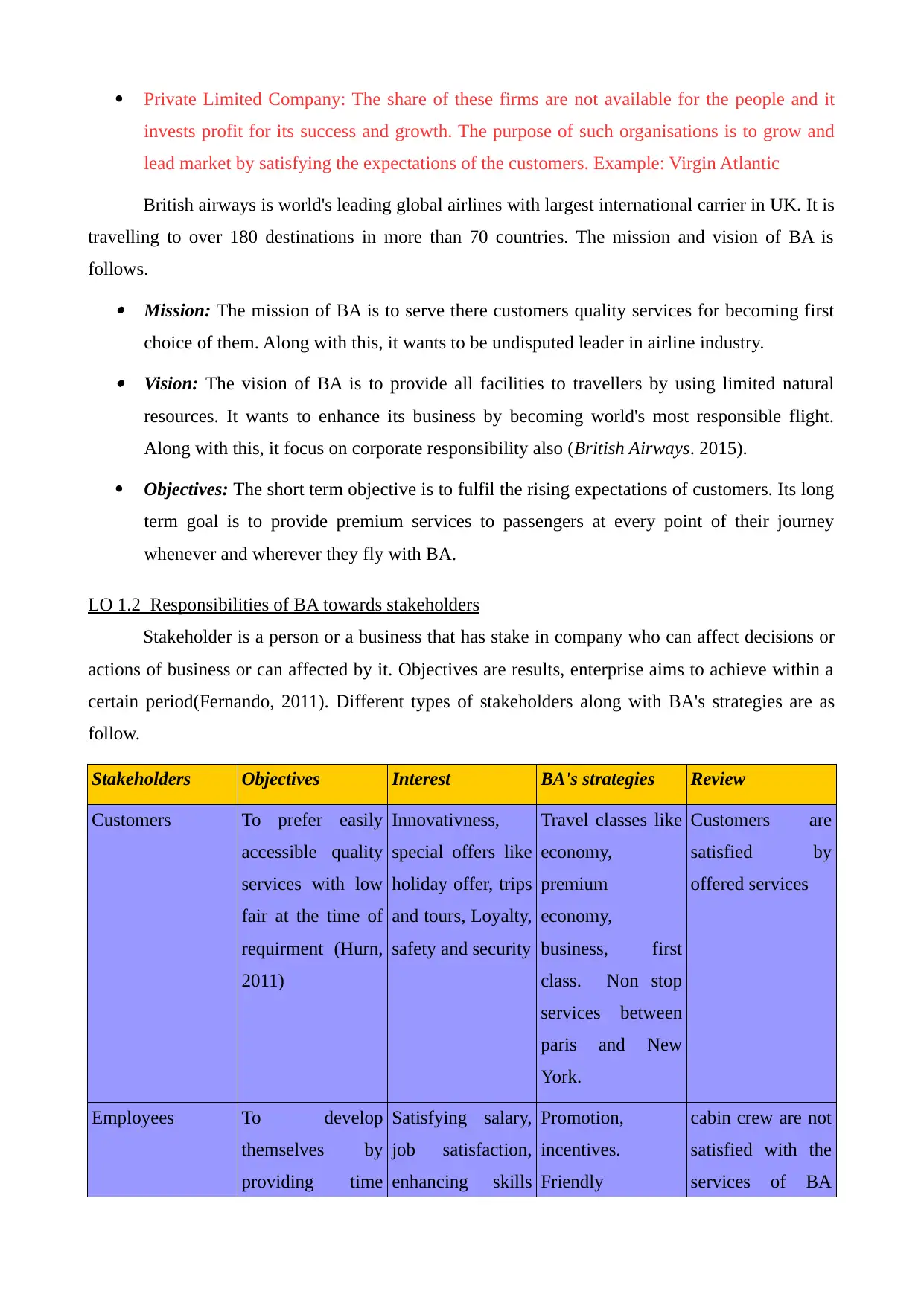
Private Limited Company: The share of these firms are not available for the people and it
invests profit for its success and growth. The purpose of such organisations is to grow and
lead market by satisfying the expectations of the customers. Example: Virgin Atlantic
British airways is world's leading global airlines with largest international carrier in UK. It is
travelling to over 180 destinations in more than 70 countries. The mission and vision of BA is
follows.
Mission: The mission of BA is to serve there customers quality services for becoming first
choice of them. Along with this, it wants to be undisputed leader in airline industry.
Vision: The vision of BA is to provide all facilities to travellers by using limited natural
resources. It wants to enhance its business by becoming world's most responsible flight.
Along with this, it focus on corporate responsibility also (British Airways. 2015).
Objectives: The short term objective is to fulfil the rising expectations of customers. Its long
term goal is to provide premium services to passengers at every point of their journey
whenever and wherever they fly with BA.
LO 1.2 Responsibilities of BA towards stakeholders
Stakeholder is a person or a business that has stake in company who can affect decisions or
actions of business or can affected by it. Objectives are results, enterprise aims to achieve within a
certain period(Fernando, 2011). Different types of stakeholders along with BA's strategies are as
follow.
Stakeholders Objectives Interest BA's strategies Review
Customers To prefer easily
accessible quality
services with low
fair at the time of
requirment (Hurn,
2011)
Innovativness,
special offers like
holiday offer, trips
and tours, Loyalty,
safety and security
Travel classes like
economy,
premium
economy,
business, first
class. Non stop
services between
paris and New
York.
Customers are
satisfied by
offered services
Employees To develop
themselves by
providing time
Satisfying salary,
job satisfaction,
enhancing skills
Promotion,
incentives.
Friendly
cabin crew are not
satisfied with the
services of BA
invests profit for its success and growth. The purpose of such organisations is to grow and
lead market by satisfying the expectations of the customers. Example: Virgin Atlantic
British airways is world's leading global airlines with largest international carrier in UK. It is
travelling to over 180 destinations in more than 70 countries. The mission and vision of BA is
follows.
Mission: The mission of BA is to serve there customers quality services for becoming first
choice of them. Along with this, it wants to be undisputed leader in airline industry.
Vision: The vision of BA is to provide all facilities to travellers by using limited natural
resources. It wants to enhance its business by becoming world's most responsible flight.
Along with this, it focus on corporate responsibility also (British Airways. 2015).
Objectives: The short term objective is to fulfil the rising expectations of customers. Its long
term goal is to provide premium services to passengers at every point of their journey
whenever and wherever they fly with BA.
LO 1.2 Responsibilities of BA towards stakeholders
Stakeholder is a person or a business that has stake in company who can affect decisions or
actions of business or can affected by it. Objectives are results, enterprise aims to achieve within a
certain period(Fernando, 2011). Different types of stakeholders along with BA's strategies are as
follow.
Stakeholders Objectives Interest BA's strategies Review
Customers To prefer easily
accessible quality
services with low
fair at the time of
requirment (Hurn,
2011)
Innovativness,
special offers like
holiday offer, trips
and tours, Loyalty,
safety and security
Travel classes like
economy,
premium
economy,
business, first
class. Non stop
services between
paris and New
York.
Customers are
satisfied by
offered services
Employees To develop
themselves by
providing time
Satisfying salary,
job satisfaction,
enhancing skills
Promotion,
incentives.
Friendly
cabin crew are not
satisfied with the
services of BA
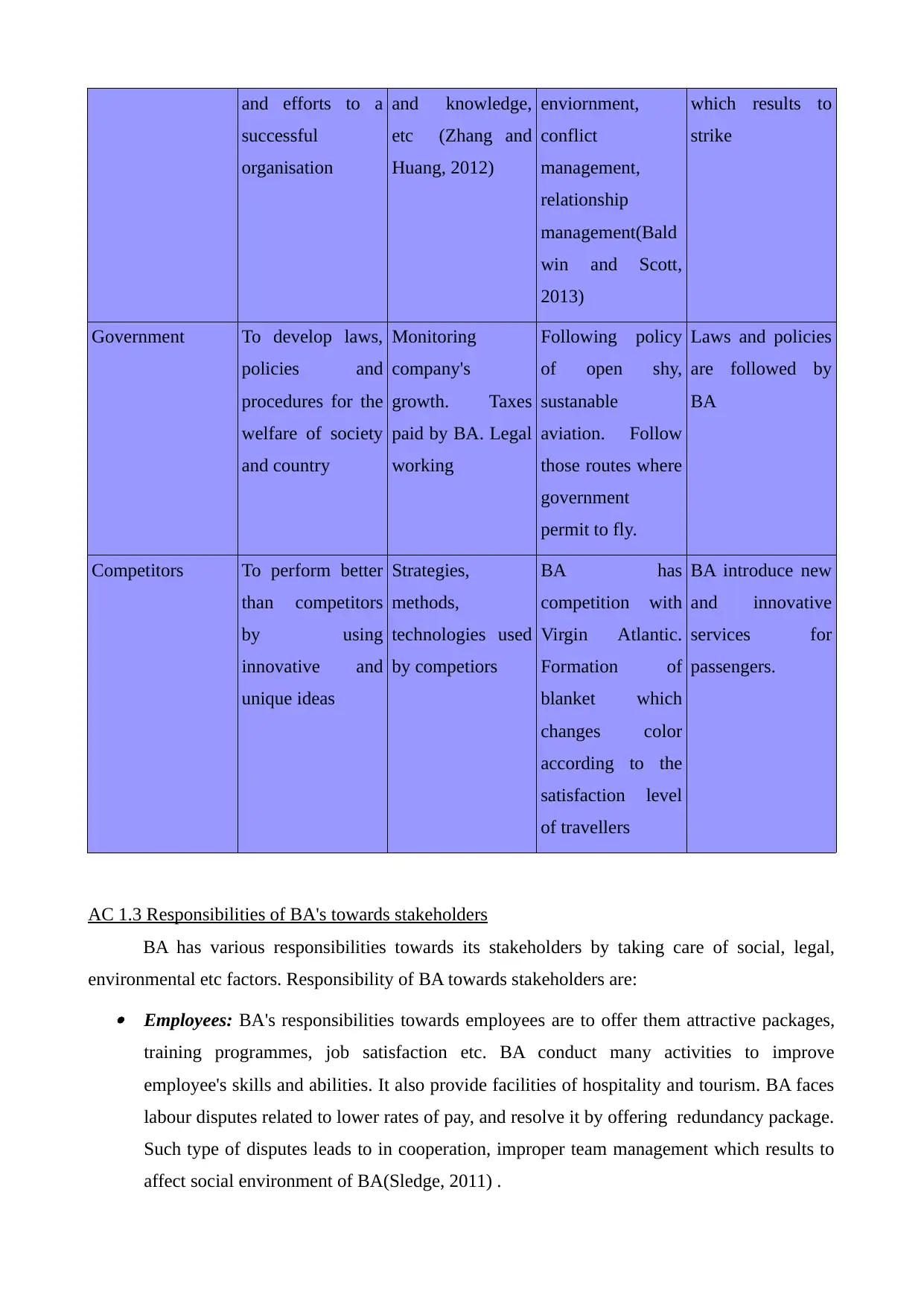
and efforts to a
successful
organisation
and knowledge,
etc (Zhang and
Huang, 2012)
enviornment,
conflict
management,
relationship
management(Bald
win and Scott,
2013)
which results to
strike
Government To develop laws,
policies and
procedures for the
welfare of society
and country
Monitoring
company's
growth. Taxes
paid by BA. Legal
working
Following policy
of open shy,
sustanable
aviation. Follow
those routes where
government
permit to fly.
Laws and policies
are followed by
BA
Competitors To perform better
than competitors
by using
innovative and
unique ideas
Strategies,
methods,
technologies used
by competiors
BA has
competition with
Virgin Atlantic.
Formation of
blanket which
changes color
according to the
satisfaction level
of travellers
BA introduce new
and innovative
services for
passengers.
AC 1.3 Responsibilities of BA's towards stakeholders
BA has various responsibilities towards its stakeholders by taking care of social, legal,
environmental etc factors. Responsibility of BA towards stakeholders are:
Employees: BA's responsibilities towards employees are to offer them attractive packages,
training programmes, job satisfaction etc. BA conduct many activities to improve
employee's skills and abilities. It also provide facilities of hospitality and tourism. BA faces
labour disputes related to lower rates of pay, and resolve it by offering redundancy package.
Such type of disputes leads to in cooperation, improper team management which results to
affect social environment of BA(Sledge, 2011) .
successful
organisation
and knowledge,
etc (Zhang and
Huang, 2012)
enviornment,
conflict
management,
relationship
management(Bald
win and Scott,
2013)
which results to
strike
Government To develop laws,
policies and
procedures for the
welfare of society
and country
Monitoring
company's
growth. Taxes
paid by BA. Legal
working
Following policy
of open shy,
sustanable
aviation. Follow
those routes where
government
permit to fly.
Laws and policies
are followed by
BA
Competitors To perform better
than competitors
by using
innovative and
unique ideas
Strategies,
methods,
technologies used
by competiors
BA has
competition with
Virgin Atlantic.
Formation of
blanket which
changes color
according to the
satisfaction level
of travellers
BA introduce new
and innovative
services for
passengers.
AC 1.3 Responsibilities of BA's towards stakeholders
BA has various responsibilities towards its stakeholders by taking care of social, legal,
environmental etc factors. Responsibility of BA towards stakeholders are:
Employees: BA's responsibilities towards employees are to offer them attractive packages,
training programmes, job satisfaction etc. BA conduct many activities to improve
employee's skills and abilities. It also provide facilities of hospitality and tourism. BA faces
labour disputes related to lower rates of pay, and resolve it by offering redundancy package.
Such type of disputes leads to in cooperation, improper team management which results to
affect social environment of BA(Sledge, 2011) .
⊘ This is a preview!⊘
Do you want full access?
Subscribe today to unlock all pages.

Trusted by 1+ million students worldwide
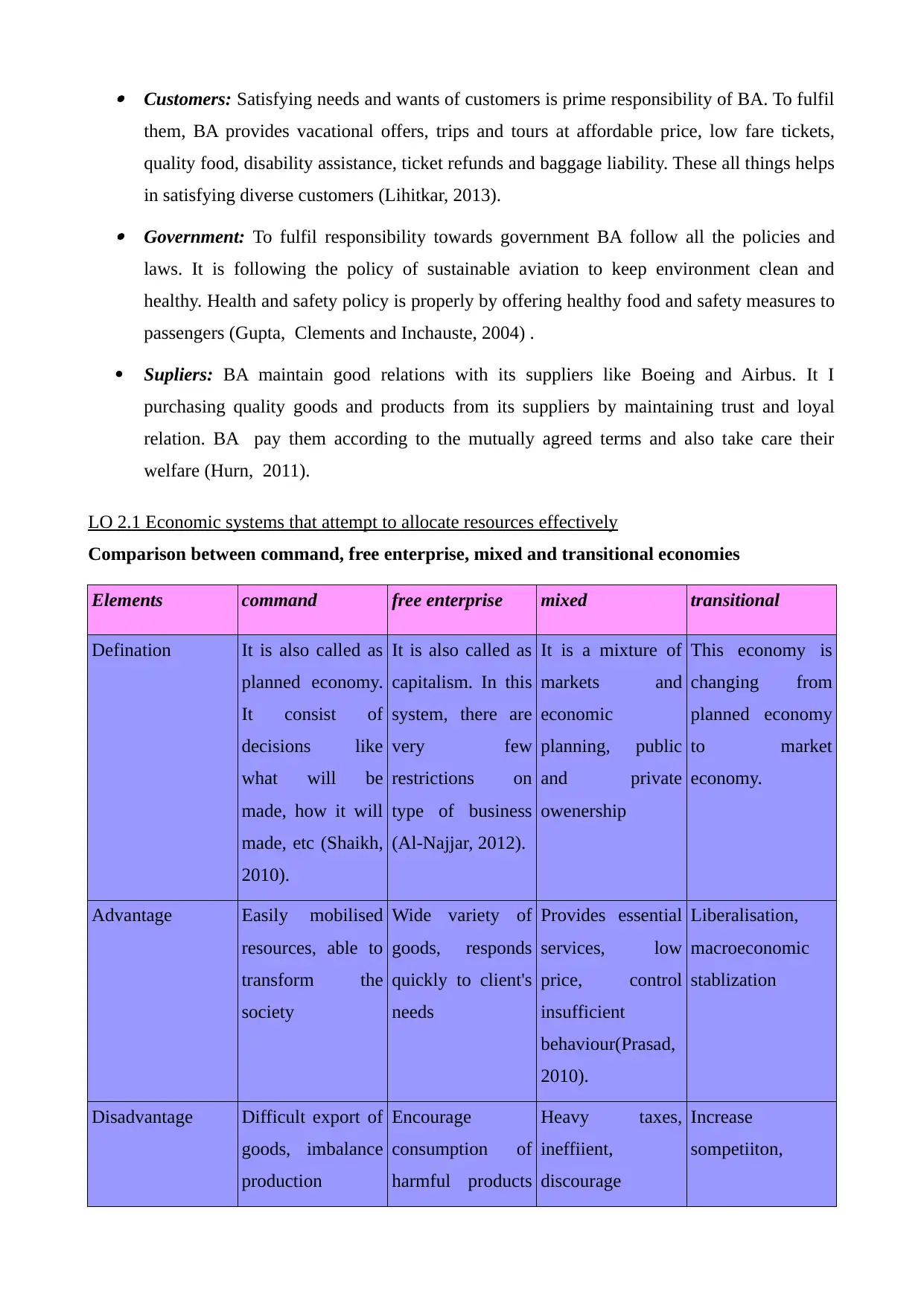
Customers: Satisfying needs and wants of customers is prime responsibility of BA. To fulfil
them, BA provides vacational offers, trips and tours at affordable price, low fare tickets,
quality food, disability assistance, ticket refunds and baggage liability. These all things helps
in satisfying diverse customers (Lihitkar, 2013).
Government: To fulfil responsibility towards government BA follow all the policies and
laws. It is following the policy of sustainable aviation to keep environment clean and
healthy. Health and safety policy is properly by offering healthy food and safety measures to
passengers (Gupta, Clements and Inchauste, 2004) .
Supliers: BA maintain good relations with its suppliers like Boeing and Airbus. It I
purchasing quality goods and products from its suppliers by maintaining trust and loyal
relation. BA pay them according to the mutually agreed terms and also take care their
welfare (Hurn, 2011).
LO 2.1 Economic systems that attempt to allocate resources effectively
Comparison between command, free enterprise, mixed and transitional economies
Elements command free enterprise mixed transitional
Defination It is also called as
planned economy.
It consist of
decisions like
what will be
made, how it will
made, etc (Shaikh,
2010).
It is also called as
capitalism. In this
system, there are
very few
restrictions on
type of business
(Al-Najjar, 2012).
It is a mixture of
markets and
economic
planning, public
and private
owenership
This economy is
changing from
planned economy
to market
economy.
Advantage Easily mobilised
resources, able to
transform the
society
Wide variety of
goods, responds
quickly to client's
needs
Provides essential
services, low
price, control
insufficient
behaviour(Prasad,
2010).
Liberalisation,
macroeconomic
stablization
Disadvantage Difficult export of
goods, imbalance
production
Encourage
consumption of
harmful products
Heavy taxes,
ineffiient,
discourage
Increase
sompetiiton,
them, BA provides vacational offers, trips and tours at affordable price, low fare tickets,
quality food, disability assistance, ticket refunds and baggage liability. These all things helps
in satisfying diverse customers (Lihitkar, 2013).
Government: To fulfil responsibility towards government BA follow all the policies and
laws. It is following the policy of sustainable aviation to keep environment clean and
healthy. Health and safety policy is properly by offering healthy food and safety measures to
passengers (Gupta, Clements and Inchauste, 2004) .
Supliers: BA maintain good relations with its suppliers like Boeing and Airbus. It I
purchasing quality goods and products from its suppliers by maintaining trust and loyal
relation. BA pay them according to the mutually agreed terms and also take care their
welfare (Hurn, 2011).
LO 2.1 Economic systems that attempt to allocate resources effectively
Comparison between command, free enterprise, mixed and transitional economies
Elements command free enterprise mixed transitional
Defination It is also called as
planned economy.
It consist of
decisions like
what will be
made, how it will
made, etc (Shaikh,
2010).
It is also called as
capitalism. In this
system, there are
very few
restrictions on
type of business
(Al-Najjar, 2012).
It is a mixture of
markets and
economic
planning, public
and private
owenership
This economy is
changing from
planned economy
to market
economy.
Advantage Easily mobilised
resources, able to
transform the
society
Wide variety of
goods, responds
quickly to client's
needs
Provides essential
services, low
price, control
insufficient
behaviour(Prasad,
2010).
Liberalisation,
macroeconomic
stablization
Disadvantage Difficult export of
goods, imbalance
production
Encourage
consumption of
harmful products
Heavy taxes,
ineffiient,
discourage
Increase
sompetiiton,
Paraphrase This Document
Need a fresh take? Get an instant paraphrase of this document with our AI Paraphraser
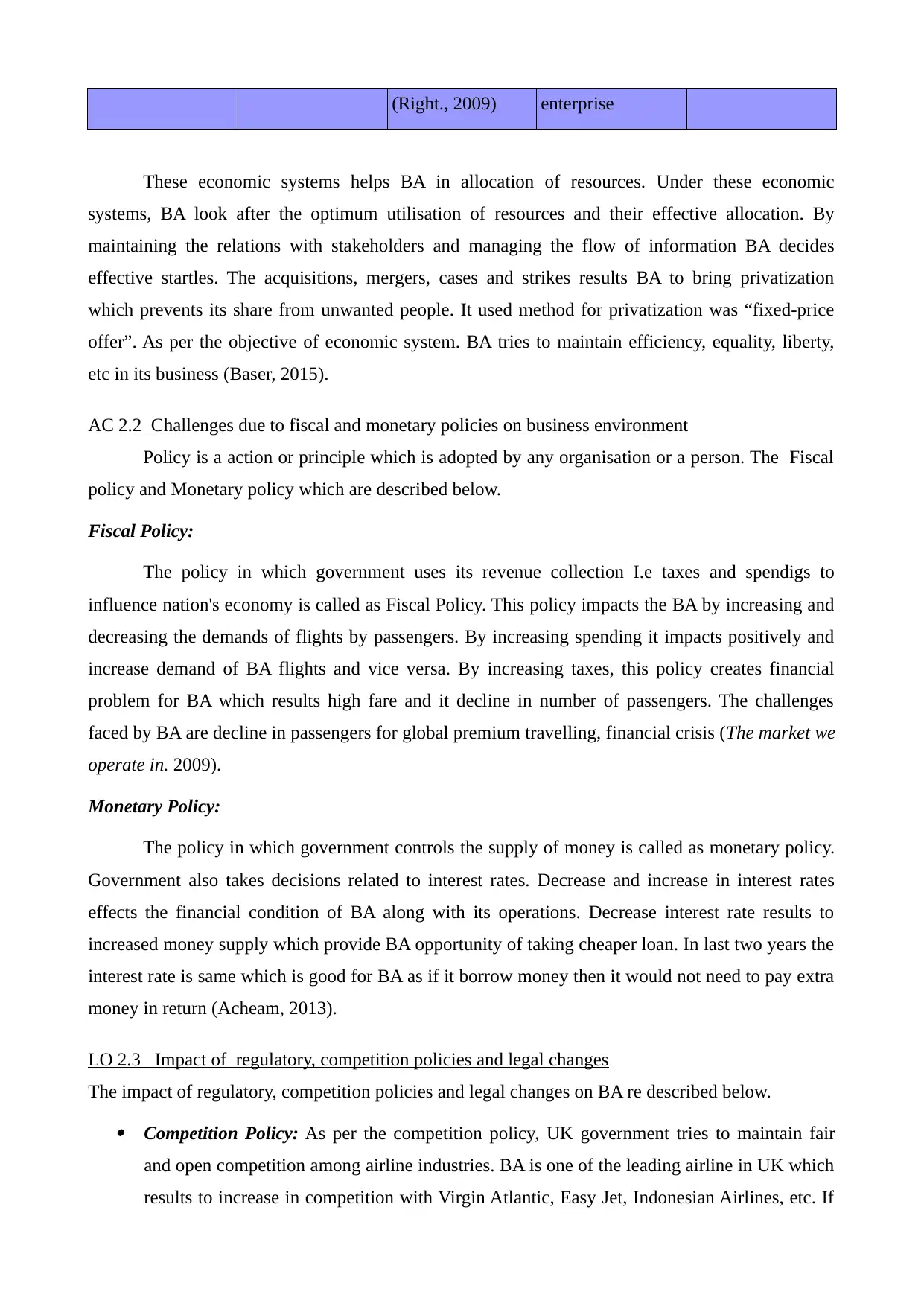
(Right., 2009) enterprise
These economic systems helps BA in allocation of resources. Under these economic
systems, BA look after the optimum utilisation of resources and their effective allocation. By
maintaining the relations with stakeholders and managing the flow of information BA decides
effective startles. The acquisitions, mergers, cases and strikes results BA to bring privatization
which prevents its share from unwanted people. It used method for privatization was “fixed-price
offer”. As per the objective of economic system. BA tries to maintain efficiency, equality, liberty,
etc in its business (Baser, 2015).
AC 2.2 Challenges due to fiscal and monetary policies on business environment
Policy is a action or principle which is adopted by any organisation or a person. The Fiscal
policy and Monetary policy which are described below.
Fiscal Policy:
The policy in which government uses its revenue collection I.e taxes and spendigs to
influence nation's economy is called as Fiscal Policy. This policy impacts the BA by increasing and
decreasing the demands of flights by passengers. By increasing spending it impacts positively and
increase demand of BA flights and vice versa. By increasing taxes, this policy creates financial
problem for BA which results high fare and it decline in number of passengers. The challenges
faced by BA are decline in passengers for global premium travelling, financial crisis (The market we
operate in. 2009).
Monetary Policy:
The policy in which government controls the supply of money is called as monetary policy.
Government also takes decisions related to interest rates. Decrease and increase in interest rates
effects the financial condition of BA along with its operations. Decrease interest rate results to
increased money supply which provide BA opportunity of taking cheaper loan. In last two years the
interest rate is same which is good for BA as if it borrow money then it would not need to pay extra
money in return (Acheam, 2013).
LO 2.3 Impact of regulatory, competition policies and legal changes
The impact of regulatory, competition policies and legal changes on BA re described below.
Competition Policy: As per the competition policy, UK government tries to maintain fair
and open competition among airline industries. BA is one of the leading airline in UK which
results to increase in competition with Virgin Atlantic, Easy Jet, Indonesian Airlines, etc. If
These economic systems helps BA in allocation of resources. Under these economic
systems, BA look after the optimum utilisation of resources and their effective allocation. By
maintaining the relations with stakeholders and managing the flow of information BA decides
effective startles. The acquisitions, mergers, cases and strikes results BA to bring privatization
which prevents its share from unwanted people. It used method for privatization was “fixed-price
offer”. As per the objective of economic system. BA tries to maintain efficiency, equality, liberty,
etc in its business (Baser, 2015).
AC 2.2 Challenges due to fiscal and monetary policies on business environment
Policy is a action or principle which is adopted by any organisation or a person. The Fiscal
policy and Monetary policy which are described below.
Fiscal Policy:
The policy in which government uses its revenue collection I.e taxes and spendigs to
influence nation's economy is called as Fiscal Policy. This policy impacts the BA by increasing and
decreasing the demands of flights by passengers. By increasing spending it impacts positively and
increase demand of BA flights and vice versa. By increasing taxes, this policy creates financial
problem for BA which results high fare and it decline in number of passengers. The challenges
faced by BA are decline in passengers for global premium travelling, financial crisis (The market we
operate in. 2009).
Monetary Policy:
The policy in which government controls the supply of money is called as monetary policy.
Government also takes decisions related to interest rates. Decrease and increase in interest rates
effects the financial condition of BA along with its operations. Decrease interest rate results to
increased money supply which provide BA opportunity of taking cheaper loan. In last two years the
interest rate is same which is good for BA as if it borrow money then it would not need to pay extra
money in return (Acheam, 2013).
LO 2.3 Impact of regulatory, competition policies and legal changes
The impact of regulatory, competition policies and legal changes on BA re described below.
Competition Policy: As per the competition policy, UK government tries to maintain fair
and open competition among airline industries. BA is one of the leading airline in UK which
results to increase in competition with Virgin Atlantic, Easy Jet, Indonesian Airlines, etc. If
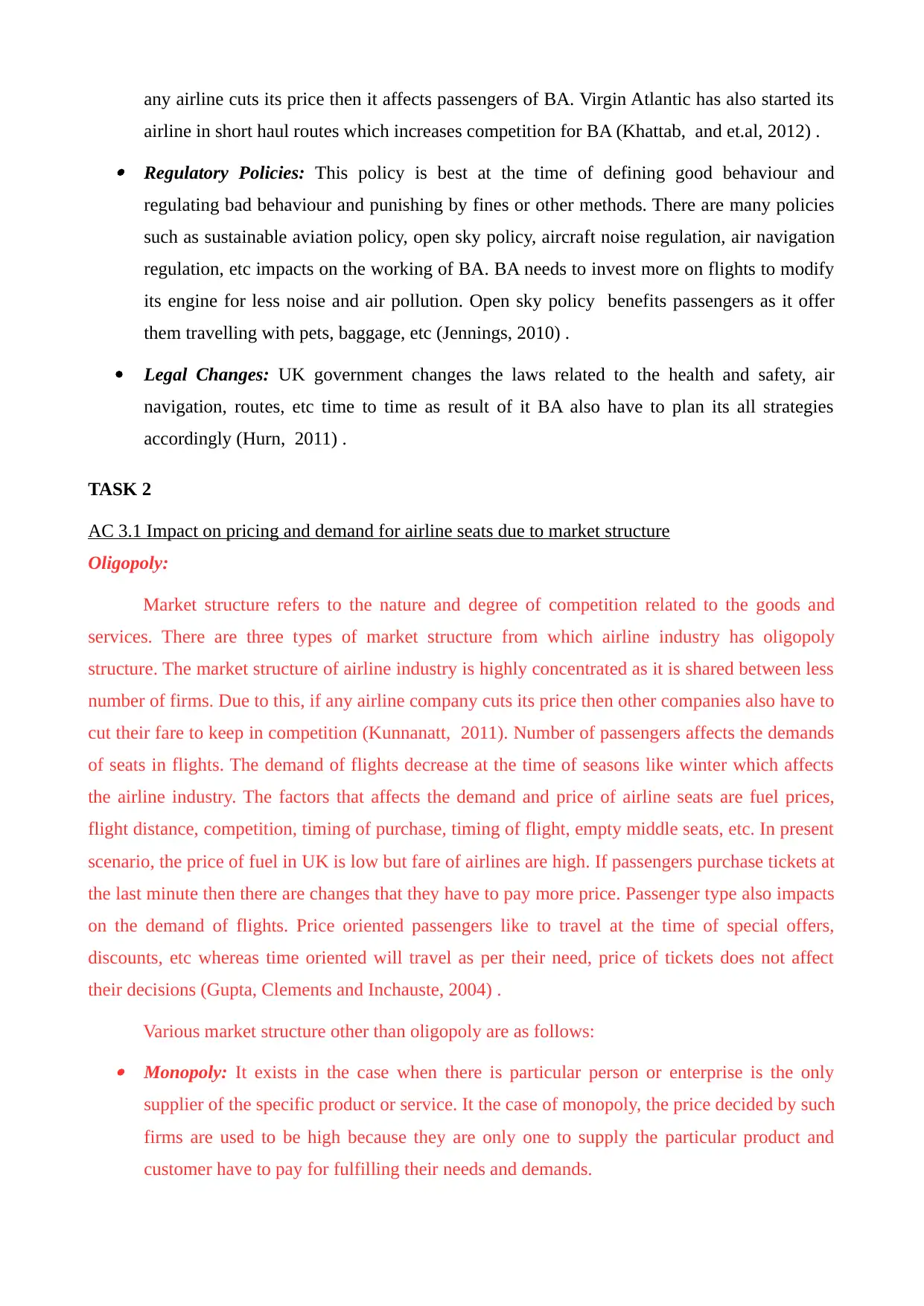
any airline cuts its price then it affects passengers of BA. Virgin Atlantic has also started its
airline in short haul routes which increases competition for BA (Khattab, and et.al, 2012) .
Regulatory Policies: This policy is best at the time of defining good behaviour and
regulating bad behaviour and punishing by fines or other methods. There are many policies
such as sustainable aviation policy, open sky policy, aircraft noise regulation, air navigation
regulation, etc impacts on the working of BA. BA needs to invest more on flights to modify
its engine for less noise and air pollution. Open sky policy benefits passengers as it offer
them travelling with pets, baggage, etc (Jennings, 2010) .
Legal Changes: UK government changes the laws related to the health and safety, air
navigation, routes, etc time to time as result of it BA also have to plan its all strategies
accordingly (Hurn, 2011) .
TASK 2
AC 3.1 Impact on pricing and demand for airline seats due to market structure
Oligopoly:
Market structure refers to the nature and degree of competition related to the goods and
services. There are three types of market structure from which airline industry has oligopoly
structure. The market structure of airline industry is highly concentrated as it is shared between less
number of firms. Due to this, if any airline company cuts its price then other companies also have to
cut their fare to keep in competition (Kunnanatt, 2011). Number of passengers affects the demands
of seats in flights. The demand of flights decrease at the time of seasons like winter which affects
the airline industry. The factors that affects the demand and price of airline seats are fuel prices,
flight distance, competition, timing of purchase, timing of flight, empty middle seats, etc. In present
scenario, the price of fuel in UK is low but fare of airlines are high. If passengers purchase tickets at
the last minute then there are changes that they have to pay more price. Passenger type also impacts
on the demand of flights. Price oriented passengers like to travel at the time of special offers,
discounts, etc whereas time oriented will travel as per their need, price of tickets does not affect
their decisions (Gupta, Clements and Inchauste, 2004) .
Various market structure other than oligopoly are as follows:
Monopoly: It exists in the case when there is particular person or enterprise is the only
supplier of the specific product or service. It the case of monopoly, the price decided by such
firms are used to be high because they are only one to supply the particular product and
customer have to pay for fulfilling their needs and demands.
airline in short haul routes which increases competition for BA (Khattab, and et.al, 2012) .
Regulatory Policies: This policy is best at the time of defining good behaviour and
regulating bad behaviour and punishing by fines or other methods. There are many policies
such as sustainable aviation policy, open sky policy, aircraft noise regulation, air navigation
regulation, etc impacts on the working of BA. BA needs to invest more on flights to modify
its engine for less noise and air pollution. Open sky policy benefits passengers as it offer
them travelling with pets, baggage, etc (Jennings, 2010) .
Legal Changes: UK government changes the laws related to the health and safety, air
navigation, routes, etc time to time as result of it BA also have to plan its all strategies
accordingly (Hurn, 2011) .
TASK 2
AC 3.1 Impact on pricing and demand for airline seats due to market structure
Oligopoly:
Market structure refers to the nature and degree of competition related to the goods and
services. There are three types of market structure from which airline industry has oligopoly
structure. The market structure of airline industry is highly concentrated as it is shared between less
number of firms. Due to this, if any airline company cuts its price then other companies also have to
cut their fare to keep in competition (Kunnanatt, 2011). Number of passengers affects the demands
of seats in flights. The demand of flights decrease at the time of seasons like winter which affects
the airline industry. The factors that affects the demand and price of airline seats are fuel prices,
flight distance, competition, timing of purchase, timing of flight, empty middle seats, etc. In present
scenario, the price of fuel in UK is low but fare of airlines are high. If passengers purchase tickets at
the last minute then there are changes that they have to pay more price. Passenger type also impacts
on the demand of flights. Price oriented passengers like to travel at the time of special offers,
discounts, etc whereas time oriented will travel as per their need, price of tickets does not affect
their decisions (Gupta, Clements and Inchauste, 2004) .
Various market structure other than oligopoly are as follows:
Monopoly: It exists in the case when there is particular person or enterprise is the only
supplier of the specific product or service. It the case of monopoly, the price decided by such
firms are used to be high because they are only one to supply the particular product and
customer have to pay for fulfilling their needs and demands.
⊘ This is a preview!⊘
Do you want full access?
Subscribe today to unlock all pages.

Trusted by 1+ million students worldwide
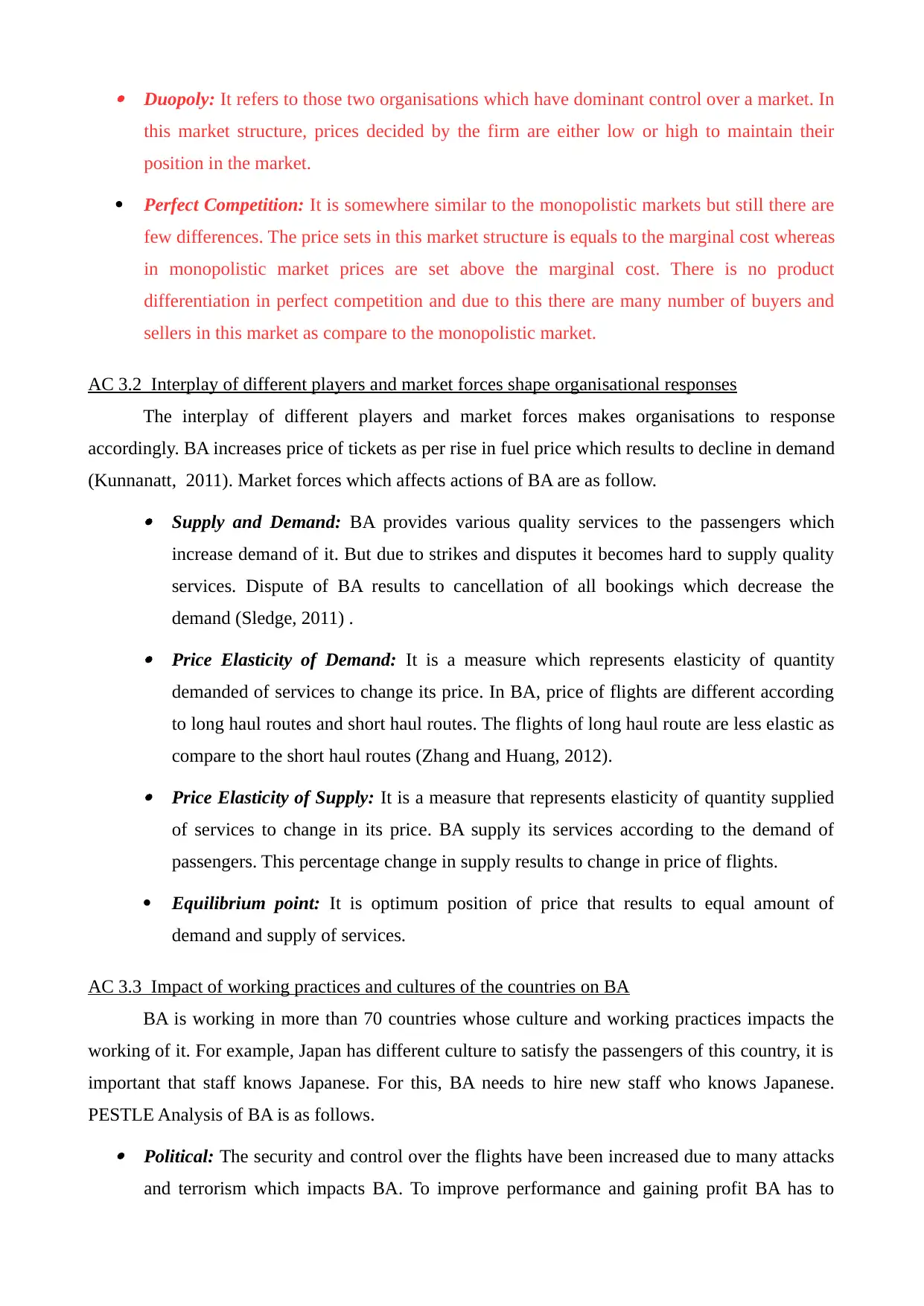
Duopoly: It refers to those two organisations which have dominant control over a market. In
this market structure, prices decided by the firm are either low or high to maintain their
position in the market.
Perfect Competition: It is somewhere similar to the monopolistic markets but still there are
few differences. The price sets in this market structure is equals to the marginal cost whereas
in monopolistic market prices are set above the marginal cost. There is no product
differentiation in perfect competition and due to this there are many number of buyers and
sellers in this market as compare to the monopolistic market.
AC 3.2 Interplay of different players and market forces shape organisational responses
The interplay of different players and market forces makes organisations to response
accordingly. BA increases price of tickets as per rise in fuel price which results to decline in demand
(Kunnanatt, 2011). Market forces which affects actions of BA are as follow. Supply and Demand: BA provides various quality services to the passengers which
increase demand of it. But due to strikes and disputes it becomes hard to supply quality
services. Dispute of BA results to cancellation of all bookings which decrease the
demand (Sledge, 2011) . Price Elasticity of Demand: It is a measure which represents elasticity of quantity
demanded of services to change its price. In BA, price of flights are different according
to long haul routes and short haul routes. The flights of long haul route are less elastic as
compare to the short haul routes (Zhang and Huang, 2012). Price Elasticity of Supply: It is a measure that represents elasticity of quantity supplied
of services to change in its price. BA supply its services according to the demand of
passengers. This percentage change in supply results to change in price of flights.
Equilibrium point: It is optimum position of price that results to equal amount of
demand and supply of services.
AC 3.3 Impact of working practices and cultures of the countries on BA
BA is working in more than 70 countries whose culture and working practices impacts the
working of it. For example, Japan has different culture to satisfy the passengers of this country, it is
important that staff knows Japanese. For this, BA needs to hire new staff who knows Japanese.
PESTLE Analysis of BA is as follows.
Political: The security and control over the flights have been increased due to many attacks
and terrorism which impacts BA. To improve performance and gaining profit BA has to
this market structure, prices decided by the firm are either low or high to maintain their
position in the market.
Perfect Competition: It is somewhere similar to the monopolistic markets but still there are
few differences. The price sets in this market structure is equals to the marginal cost whereas
in monopolistic market prices are set above the marginal cost. There is no product
differentiation in perfect competition and due to this there are many number of buyers and
sellers in this market as compare to the monopolistic market.
AC 3.2 Interplay of different players and market forces shape organisational responses
The interplay of different players and market forces makes organisations to response
accordingly. BA increases price of tickets as per rise in fuel price which results to decline in demand
(Kunnanatt, 2011). Market forces which affects actions of BA are as follow. Supply and Demand: BA provides various quality services to the passengers which
increase demand of it. But due to strikes and disputes it becomes hard to supply quality
services. Dispute of BA results to cancellation of all bookings which decrease the
demand (Sledge, 2011) . Price Elasticity of Demand: It is a measure which represents elasticity of quantity
demanded of services to change its price. In BA, price of flights are different according
to long haul routes and short haul routes. The flights of long haul route are less elastic as
compare to the short haul routes (Zhang and Huang, 2012). Price Elasticity of Supply: It is a measure that represents elasticity of quantity supplied
of services to change in its price. BA supply its services according to the demand of
passengers. This percentage change in supply results to change in price of flights.
Equilibrium point: It is optimum position of price that results to equal amount of
demand and supply of services.
AC 3.3 Impact of working practices and cultures of the countries on BA
BA is working in more than 70 countries whose culture and working practices impacts the
working of it. For example, Japan has different culture to satisfy the passengers of this country, it is
important that staff knows Japanese. For this, BA needs to hire new staff who knows Japanese.
PESTLE Analysis of BA is as follows.
Political: The security and control over the flights have been increased due to many attacks
and terrorism which impacts BA. To improve performance and gaining profit BA has to
Paraphrase This Document
Need a fresh take? Get an instant paraphrase of this document with our AI Paraphraser
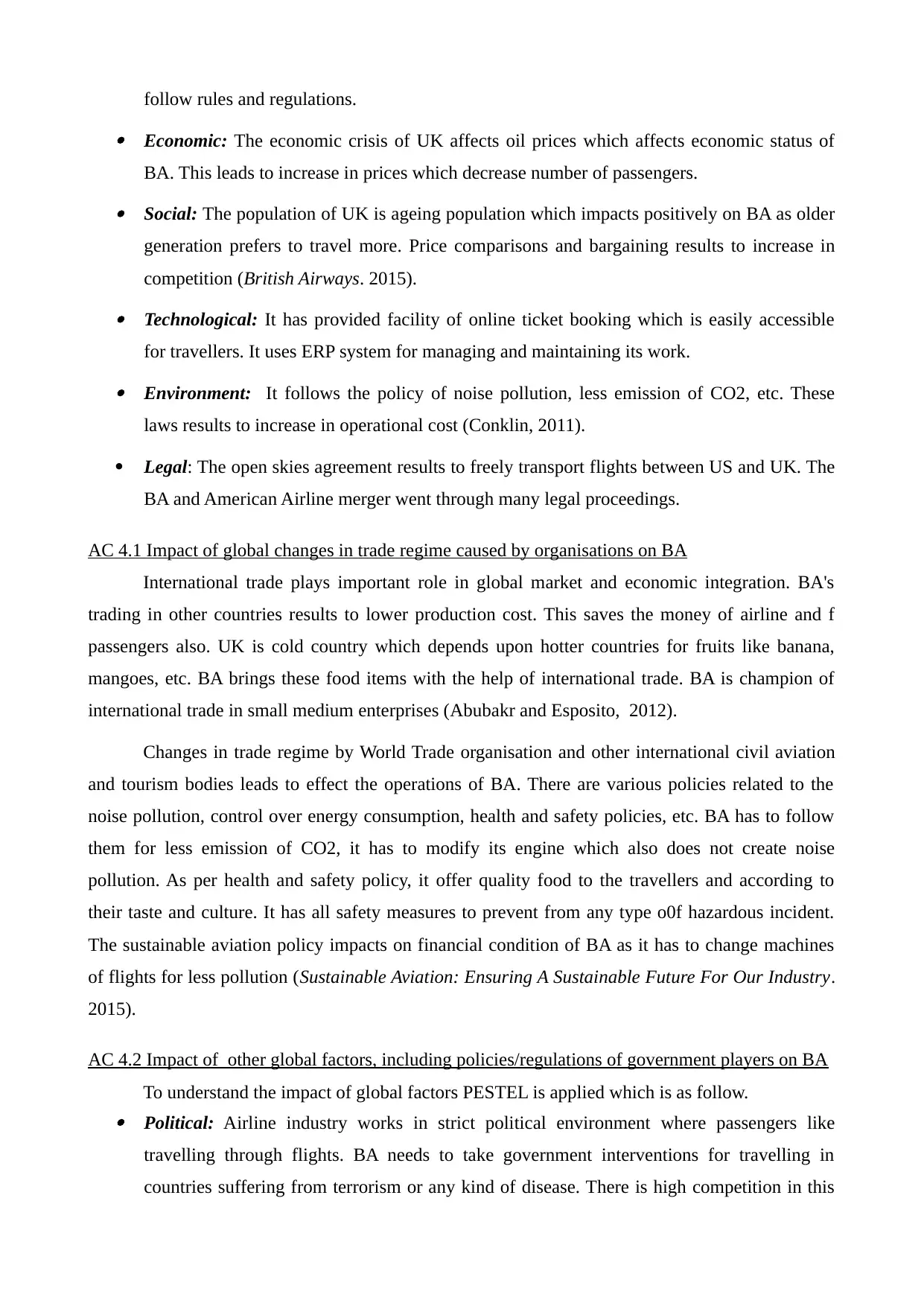
follow rules and regulations.
Economic: The economic crisis of UK affects oil prices which affects economic status of
BA. This leads to increase in prices which decrease number of passengers.
Social: The population of UK is ageing population which impacts positively on BA as older
generation prefers to travel more. Price comparisons and bargaining results to increase in
competition (British Airways. 2015).
Technological: It has provided facility of online ticket booking which is easily accessible
for travellers. It uses ERP system for managing and maintaining its work.
Environment: It follows the policy of noise pollution, less emission of CO2, etc. These
laws results to increase in operational cost (Conklin, 2011).
Legal: The open skies agreement results to freely transport flights between US and UK. The
BA and American Airline merger went through many legal proceedings.
AC 4.1 Impact of global changes in trade regime caused by organisations on BA
International trade plays important role in global market and economic integration. BA's
trading in other countries results to lower production cost. This saves the money of airline and f
passengers also. UK is cold country which depends upon hotter countries for fruits like banana,
mangoes, etc. BA brings these food items with the help of international trade. BA is champion of
international trade in small medium enterprises (Abubakr and Esposito, 2012).
Changes in trade regime by World Trade organisation and other international civil aviation
and tourism bodies leads to effect the operations of BA. There are various policies related to the
noise pollution, control over energy consumption, health and safety policies, etc. BA has to follow
them for less emission of CO2, it has to modify its engine which also does not create noise
pollution. As per health and safety policy, it offer quality food to the travellers and according to
their taste and culture. It has all safety measures to prevent from any type o0f hazardous incident.
The sustainable aviation policy impacts on financial condition of BA as it has to change machines
of flights for less pollution (Sustainable Aviation: Ensuring A Sustainable Future For Our Industry.
2015).
AC 4.2 Impact of other global factors, including policies/regulations of government players on BA
To understand the impact of global factors PESTEL is applied which is as follow. Political: Airline industry works in strict political environment where passengers like
travelling through flights. BA needs to take government interventions for travelling in
countries suffering from terrorism or any kind of disease. There is high competition in this
Economic: The economic crisis of UK affects oil prices which affects economic status of
BA. This leads to increase in prices which decrease number of passengers.
Social: The population of UK is ageing population which impacts positively on BA as older
generation prefers to travel more. Price comparisons and bargaining results to increase in
competition (British Airways. 2015).
Technological: It has provided facility of online ticket booking which is easily accessible
for travellers. It uses ERP system for managing and maintaining its work.
Environment: It follows the policy of noise pollution, less emission of CO2, etc. These
laws results to increase in operational cost (Conklin, 2011).
Legal: The open skies agreement results to freely transport flights between US and UK. The
BA and American Airline merger went through many legal proceedings.
AC 4.1 Impact of global changes in trade regime caused by organisations on BA
International trade plays important role in global market and economic integration. BA's
trading in other countries results to lower production cost. This saves the money of airline and f
passengers also. UK is cold country which depends upon hotter countries for fruits like banana,
mangoes, etc. BA brings these food items with the help of international trade. BA is champion of
international trade in small medium enterprises (Abubakr and Esposito, 2012).
Changes in trade regime by World Trade organisation and other international civil aviation
and tourism bodies leads to effect the operations of BA. There are various policies related to the
noise pollution, control over energy consumption, health and safety policies, etc. BA has to follow
them for less emission of CO2, it has to modify its engine which also does not create noise
pollution. As per health and safety policy, it offer quality food to the travellers and according to
their taste and culture. It has all safety measures to prevent from any type o0f hazardous incident.
The sustainable aviation policy impacts on financial condition of BA as it has to change machines
of flights for less pollution (Sustainable Aviation: Ensuring A Sustainable Future For Our Industry.
2015).
AC 4.2 Impact of other global factors, including policies/regulations of government players on BA
To understand the impact of global factors PESTEL is applied which is as follow. Political: Airline industry works in strict political environment where passengers like
travelling through flights. BA needs to take government interventions for travelling in
countries suffering from terrorism or any kind of disease. There is high competition in this
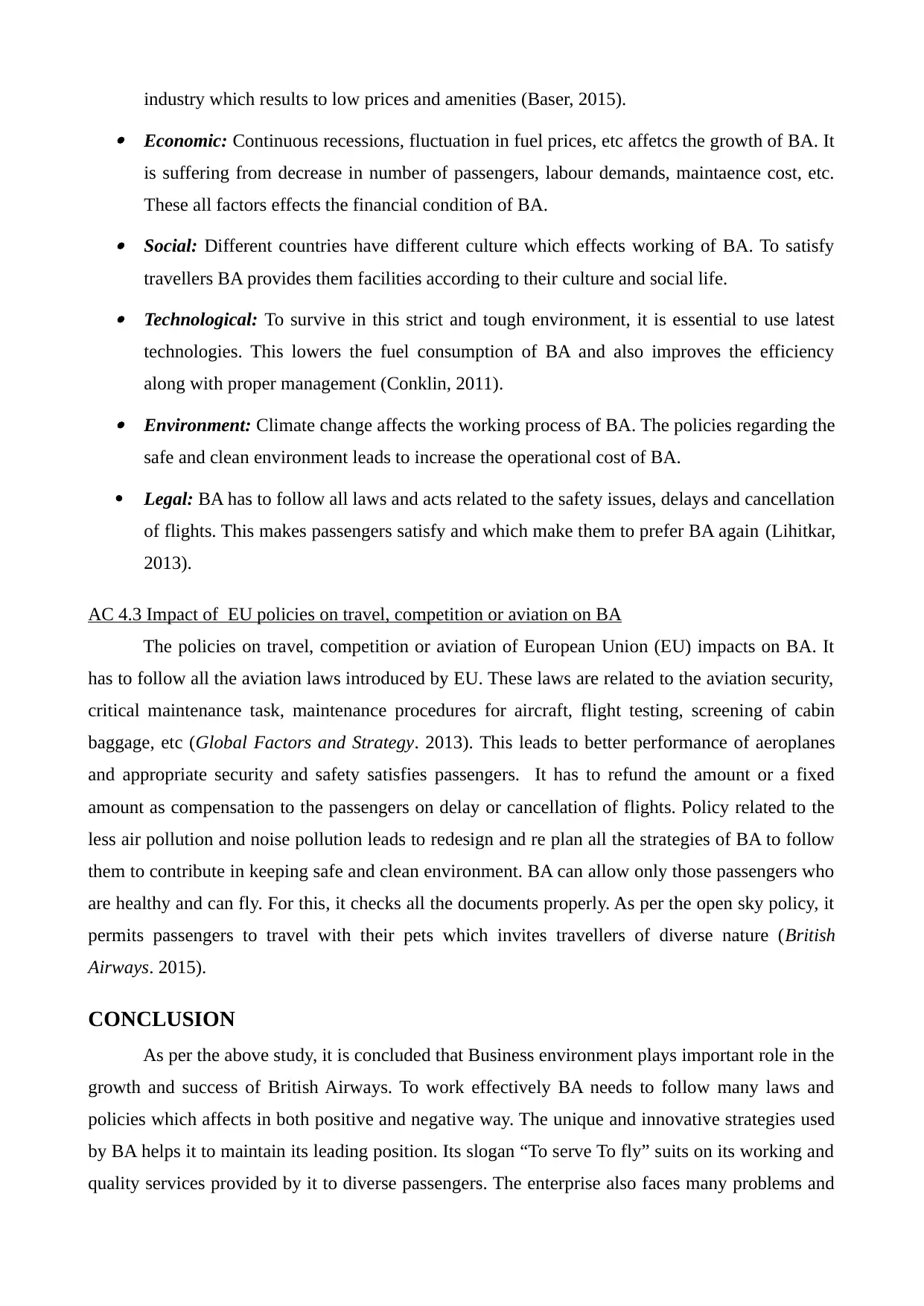
industry which results to low prices and amenities (Baser, 2015).
Economic: Continuous recessions, fluctuation in fuel prices, etc affetcs the growth of BA. It
is suffering from decrease in number of passengers, labour demands, maintaence cost, etc.
These all factors effects the financial condition of BA.
Social: Different countries have different culture which effects working of BA. To satisfy
travellers BA provides them facilities according to their culture and social life.
Technological: To survive in this strict and tough environment, it is essential to use latest
technologies. This lowers the fuel consumption of BA and also improves the efficiency
along with proper management (Conklin, 2011).
Environment: Climate change affects the working process of BA. The policies regarding the
safe and clean environment leads to increase the operational cost of BA.
Legal: BA has to follow all laws and acts related to the safety issues, delays and cancellation
of flights. This makes passengers satisfy and which make them to prefer BA again (Lihitkar,
2013).
AC 4.3 Impact of EU policies on travel, competition or aviation on BA
The policies on travel, competition or aviation of European Union (EU) impacts on BA. It
has to follow all the aviation laws introduced by EU. These laws are related to the aviation security,
critical maintenance task, maintenance procedures for aircraft, flight testing, screening of cabin
baggage, etc (Global Factors and Strategy. 2013). This leads to better performance of aeroplanes
and appropriate security and safety satisfies passengers. It has to refund the amount or a fixed
amount as compensation to the passengers on delay or cancellation of flights. Policy related to the
less air pollution and noise pollution leads to redesign and re plan all the strategies of BA to follow
them to contribute in keeping safe and clean environment. BA can allow only those passengers who
are healthy and can fly. For this, it checks all the documents properly. As per the open sky policy, it
permits passengers to travel with their pets which invites travellers of diverse nature (British
Airways. 2015).
CONCLUSION
As per the above study, it is concluded that Business environment plays important role in the
growth and success of British Airways. To work effectively BA needs to follow many laws and
policies which affects in both positive and negative way. The unique and innovative strategies used
by BA helps it to maintain its leading position. Its slogan “To serve To fly” suits on its working and
quality services provided by it to diverse passengers. The enterprise also faces many problems and
Economic: Continuous recessions, fluctuation in fuel prices, etc affetcs the growth of BA. It
is suffering from decrease in number of passengers, labour demands, maintaence cost, etc.
These all factors effects the financial condition of BA.
Social: Different countries have different culture which effects working of BA. To satisfy
travellers BA provides them facilities according to their culture and social life.
Technological: To survive in this strict and tough environment, it is essential to use latest
technologies. This lowers the fuel consumption of BA and also improves the efficiency
along with proper management (Conklin, 2011).
Environment: Climate change affects the working process of BA. The policies regarding the
safe and clean environment leads to increase the operational cost of BA.
Legal: BA has to follow all laws and acts related to the safety issues, delays and cancellation
of flights. This makes passengers satisfy and which make them to prefer BA again (Lihitkar,
2013).
AC 4.3 Impact of EU policies on travel, competition or aviation on BA
The policies on travel, competition or aviation of European Union (EU) impacts on BA. It
has to follow all the aviation laws introduced by EU. These laws are related to the aviation security,
critical maintenance task, maintenance procedures for aircraft, flight testing, screening of cabin
baggage, etc (Global Factors and Strategy. 2013). This leads to better performance of aeroplanes
and appropriate security and safety satisfies passengers. It has to refund the amount or a fixed
amount as compensation to the passengers on delay or cancellation of flights. Policy related to the
less air pollution and noise pollution leads to redesign and re plan all the strategies of BA to follow
them to contribute in keeping safe and clean environment. BA can allow only those passengers who
are healthy and can fly. For this, it checks all the documents properly. As per the open sky policy, it
permits passengers to travel with their pets which invites travellers of diverse nature (British
Airways. 2015).
CONCLUSION
As per the above study, it is concluded that Business environment plays important role in the
growth and success of British Airways. To work effectively BA needs to follow many laws and
policies which affects in both positive and negative way. The unique and innovative strategies used
by BA helps it to maintain its leading position. Its slogan “To serve To fly” suits on its working and
quality services provided by it to diverse passengers. The enterprise also faces many problems and
⊘ This is a preview!⊘
Do you want full access?
Subscribe today to unlock all pages.

Trusted by 1+ million students worldwide
1 out of 14
Related Documents
Your All-in-One AI-Powered Toolkit for Academic Success.
+13062052269
info@desklib.com
Available 24*7 on WhatsApp / Email
![[object Object]](/_next/static/media/star-bottom.7253800d.svg)
Unlock your academic potential
Copyright © 2020–2025 A2Z Services. All Rights Reserved. Developed and managed by ZUCOL.





